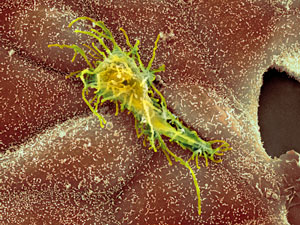Jan. 26, 2018 Research Highlight Biology
New players directing cell migration
Proteins that are a part of a complex that regulates contact between cells also play a role in cell migration
 Figure 1: A carcinoma cancer cell migrating along epithelial cells. The finding that catenins are involved in cell migration could have implications for preventing the spread of cancer in the body. © SCIENCE PHOTO LIBRARY
Figure 1: A carcinoma cancer cell migrating along epithelial cells. The finding that catenins are involved in cell migration could have implications for preventing the spread of cancer in the body. © SCIENCE PHOTO LIBRARY
RIKEN researchers have identified an unexpected player in the migration of cells—catenins, which are best known for their role in facilitating contact between cells1.
Cells have places to go. Think of a developing embryo and the intricate spatial organization of its different cell types. Or consider the spread of cancer in the body, which entails tumor cells leaving the initial tumor and migrating to other locations (Fig. 1). Both examples depend on the orchestrated efforts of various proteins that cause cells to polarize, generate force and move. But many of the proteins involved in this process are unknown.
Masatoshi Takeichi at the RIKEN Center for Developmental Biology and his team are interested in early embryonic development, particularly neural crest cells—motile cells that collectively migrate and can turn into various different types of nervous system cells.
“We were interested in whether cell−cell contacts are important for achieving the proper migration of neural crest cells,” says Takeichi.
Among the most important protein complexes that facilitate cell−cell adhesion is the cadherin−catenin complex. Cadherins span the cell membrane, and their intracellular part binds β-catenin, which interacts with αE-catenin to form this complex.
 Figure 2: Masatoshi Takeichi and his team have found a new role for catenins in cell migration. © 2018 RIKEN
Figure 2: Masatoshi Takeichi and his team have found a new role for catenins in cell migration. © 2018 RIKEN
Takeichi’s team disrupted the cadherin−catenin complex by deleting cadherin, β-catenin and αE-catenin from neural crest cells. What they found was a surprise. “The removal of this system affected cell migration even in cells that are not in contact with others,” states Takeichi.
Upon loss of catenins, the neural crest cells showed unorganized movement and were no longer able to move directionally. The researchers concluded that catenins are important not only for cell−cell adhesion but also for cell migration—a role that has not been appreciated before.
To discover how catenins affect cell migration, the team looked for their interaction with proteins that are known to drive the front–rear polarization of a cell, a prerequisite for migration. They saw that αE-catenin was essential for the correct positioning of RhoA, a small protein that controls polarity via the regulation of actin and myosin fibers.
Takeichi’s team is now investigating whether the mechanism they discovered in neural crest cells is also seen in other cell types. The answer will be the first step in determining whether these observations made in cultured cells also apply to whole organisms.
This finding raises new questions such as how a cell manages to control the different roles of catenin in cell adhesion and migration. It also has implications for medicine. “The discovery of a new mechanism to regulate cell migration may provide us with a novel cue in designing therapies for diseases involving cell migration,” notes Takeichi.
Related content
References
- 1. Vassilev, V., Platek, A., Hiver, S., Enomoto, H. & Takeichi, M. Catenins steer cell migration via stabilization of front-rear polarity. Developmental Cell 43, 463−479 (2017). doi: 10.1016/j.devcel.2017.10.014
